Characteristics of Changes in Sap Flow-Based Transpiration of Poplars, Locust Trees, and Willows and Their Response to Environmental Impact Factors
Abstract
:1. Introduction
2. Materials and Methods
2.1. Study Area
2.2. Measurement of Sapwood Area of Trees and Biological Characteristics
2.3. Sap Flow
2.4. Meteorological and Soil Moisture Measurements
2.5. MLP Model
3. Results
3.1. Trend Analysis of Meteorological Factors
3.2. Characterization of Changes in Sap Flow and Transpiration in Typical Trees
3.2.1. Characteristics of Daily Variation in Sap Flow of Typical Trees
3.2.2. Typical Tree Transpiration Pattern
3.3. Differential Analysis of Sap Flux Density Response Characteristics of Typical Trees to Meteorological Factors
3.4. Analysis of Changes in Transpiration Water Consumption Characteristics of Typical Trees in Response to Soil Moisture
3.4.1. Effect of Precipitation and Drip Irrigation on SWC
3.4.2. Correlation between Tree Transpiration and SWC
3.5. Comprehensive Analysis of Factors Influencing Transpiration Impacts on Arbor
4. Discussion
4.1. Relationship between Tree Sap Flow and Meteorological Factors
4.2. Relationship between Transpiration and SWC
5. Conclusions
Author Contributions
Funding
Data Availability Statement
Conflicts of Interest
References
- Bush, S.E.; Hultine, K.R.; Sperry, J.S.; Ehleringer, J.R. Calibration of thermal dissipation sap flow probes for ring- and diffuse-porous trees. Tree Physiol. 2010, 30, 1545–1554. [Google Scholar] [CrossRef] [PubMed]
- Martin-StPaul, N.; Delzon, S.; Cochard, H. Plant resistance to drought depends on timely stomatal closure. Ecol. Lett. 2017, 20, 1437–1447. [Google Scholar] [CrossRef] [PubMed]
- Steppe, K.; De Pauw, D.J.W.; Doody, T.M.; Teskey, R.O. A comparison of sap flux density using thermal dissipation, heat pulse velocity and heat field deformation methods. Agric. For. Meteorol. 2010, 150, 1046–1056. [Google Scholar] [CrossRef]
- Zhang, Q.; Jia, X.; Shao, M.; Zhang, C.; Li, X.; Ma, C. Sap flow of black locust in response to short-term drought in southern Loess Plateau of China. Sci. Rep. 2018, 8, 6222. [Google Scholar] [CrossRef] [PubMed]
- Flo, V.; Martinez-Vilalta, J.; Steppe, K.; Schuldt, B.; Poyatos, R. A synthesis of bias and uncertainty in sap flow methods. Agric. For. Meteorol. 2019, 271, 362–374. [Google Scholar] [CrossRef]
- Liu, J.; Li, D.; Fernández, J.-E.; Coleman, M.; Hu, W.; Di, N.; Zou, S.; Liu, Y.; Xi, B.; Clothier, B. Variations in water-balance components and carbon stocks in poplar plantations with differing water inputs over a whole rotation: Implications for sustainable forest management under climate change. Agric. For. Meteorol. 2022, 320, 108958. [Google Scholar] [CrossRef]
- Zhao, X.; Li, X.; Hu, W.; Liu, J.; Di, N.; Duan, J.; Li, D.; Liu, Y.; Guo, Y.; Wang, A.; et al. Long-term variation of the sap flow to tree diameter relation in a temperate poplar forest. J. Hydrol. 2023, 618, 129189. [Google Scholar] [CrossRef]
- Čermák, J.; Deml, M.; Penka, M. A new method of sap flow rate determination in trees. Biol. Plant. 1973, 15, 171–178. [Google Scholar] [CrossRef]
- Chen, L.; Zhang, Z.; Li, Z.; Tang, J.; Caldwell, P.; Zhang, W. Biophysical control of whole tree transpiration under an urban environment in Northern China. J. Hydrol. 2011, 402, 388–400. [Google Scholar] [CrossRef]
- Di, N.; Xi, B.; Clothier, B.; Wang, Y.; Li, G.; Jia, L. Diurnal and nocturnal transpiration behaviors and their responses to groundwater-table fluctuations and meteorological factors of Populus tomentosa in the North China Plain. For. Ecol. Manag. 2019, 448, 445–456. [Google Scholar] [CrossRef]
- Solum, J.; Malama, B. Estimating Canopy-Scale Evapotranspiration from Localized Sap Flow Measurements. Water 2022, 14, 1812. [Google Scholar] [CrossRef]
- Li, S.W.M.; Song, S.; Jia, L.; Zhang, Q. The transpiration water consumption characteristics of five typical urban trees in Yinchuan City and their impact on the main meteorological driving forces. J. Northeast. For. Univ. 2022, 50, 35–39. [Google Scholar]
- Yang, Z.; Ma, C.; Liu, Y.; Zhao, H.; Hua, Y.; Ou, S.; Fan, X. Provincial-Scale Research on the Eco-Security Structure in the Form of an Ecological Network of the Upper Yellow River: A Case Study of the Ningxia Hui Autonomous Region. Land 2023, 12, 1341. [Google Scholar] [CrossRef]
- Ma, C.; Luo, Y.; Shao, M.; Li, X.; Sun, L.; Jia, X. Environmental controls on sap flow in black locust forest in Loess Plateau, China. Sci. Rep. 2017, 7, 13160. [Google Scholar] [CrossRef] [PubMed]
- Li, S.; Yan, J.; Liu, X.; Wan, J. Response of vegetation restoration to climate change and human activities in Shaanxi-Gansu-Ningxia Region. J. Geogr. Sci. 2013, 23, 98–112. [Google Scholar] [CrossRef]
- Li, S.; Yang, S.; Liu, X.; Liu, Y.; Shi, M. NDVI-Based Analysis on the Influence of Climate Change and Human Activities on Vegetation Restoration in the Shaanxi-Gansu-Ningxia Region, Central China. Remote Sens. 2015, 7, 11163–11182. [Google Scholar] [CrossRef]
- Lü, Y.; Fu, B.; Feng, X.; Zeng, Y.; Liu, Y.; Chang, R.; Sun, G.; Wu, B. A Policy-Driven Large Scale Ecological Restoration: Quantifying Ecosystem Services Changes in the Loess Plateau of China. PLoS ONE 2012, 7, e31782. [Google Scholar] [CrossRef] [PubMed]
- Li, Z.; Sun, X.; Huang, Z.; Zhang, X.; Wang, Z.; Li, S.; Zheng, W.; Zhai, B. Changes in nutrient balance, environmental effects, and green development after returning farmland to forests: A case study in Ningxia, China. Sci. Total Environ. 2020, 735, 139370. [Google Scholar] [CrossRef]
- Xi, B.; Clothier, B.; Coleman, M.; Duan, J.; Hu, W.; Li, D.; Di, N.; Liu, Y.; Fu, J.; Li, J.; et al. Irrigation management in poplar (Populus spp.) plantations: A review. For. Ecol. Manag. 2021, 494, 119330. [Google Scholar] [CrossRef]
- Yao, L.; Zhao, M.; Xu, T. China’s Water-Saving Irrigation Management System: Policy, Implementation, and Challenge. Sustainability 2017, 9, 2339. [Google Scholar] [CrossRef]
- Gazal, R.M.; Scott, R.L.; Goodrich, D.C.; Williams, D.G. Controls on transpiration in a semiarid riparian cottonwood forest. Agric. For. Meteorol. 2006, 137, 56–67. [Google Scholar] [CrossRef]
- Asbjornsen, H.; Tomer, M.D.; Gomez-Cardenas, M.; Brudvig, L.A.; Greenan, C.M.; Schilling, K. Tree and stand transpiration in a Midwestern bur oak savanna after elm encroachment and restoration thinning. For. Ecol. Manag. 2007, 247, 209–219. [Google Scholar] [CrossRef]
- Loranty, M.M.; Mackay, D.S.; Ewers, B.E.; Adelman, J.D.; Kruger, E.L. Environmental drivers of spatial variation in whole-tree transpiration in an aspen-dominated upland-to-wetland forest gradient. Water Resour. Res. 2008, 44, W02441. [Google Scholar] [CrossRef]
- Chang, X.; Zhao, W.; He, Z. Radial pattern of sap flow and response to microclimate and soil moisture in Qinghai spruce (Picea crassifolia) in the upper Heihe River Basin of arid northwestern China. Agric. For. Meteorol. 2014, 187, 14–21. [Google Scholar] [CrossRef]
- Chen, X.; Zhao, P.; Hu, Y.; Zhao, X.; Ouyang, L.; Zhu, L.; Ni, G. The sap flow-based assessment of atmospheric trace gas uptake by three forest types in subtropical China on different timescales. Environ. Sci. Pollut. Res. Int. 2018, 25, 28431–28444. [Google Scholar] [CrossRef] [PubMed]
- Hayat, M.; Zha, T.; Jia, X.; Iqbal, S.; Qian, D.; Bourque, C.P.A.; Khan, A.; Tian, Y.; Bai, Y.; Liu, P.; et al. A multiple-temporal scale analysis of biophysical control of sap flow in Salix psammophila growing in a semiarid shrubland ecosystem of northwest China. Agric. For. Meteorol. 2020, 288–289, 107985. [Google Scholar] [CrossRef]
- Rosado, B.H.P.; Oliveira, R.S.; Joly, C.A.; Aidar, M.P.M.; Burgess, S.S.O. Diversity in nighttime transpiration behavior of woody species of the Atlantic Rain Forest, Brazil. Agric. For. Meteorol. 2012, 158–159, 13–20. [Google Scholar] [CrossRef]
- Du, S.; Wang, Y.-L.; Kume, T.; Zhang, J.-G.; Otsuki, K.; Yamanaka, N.; Liu, G.-B. Sapflow characteristics and climatic responses in three forest species in the semiarid Loess Plateau region of China. Agric. For. Meteorol. 2011, 151, 1–10. [Google Scholar] [CrossRef]
- Dang, H.; Han, H.; Chen, S.; Li, M. A fragile soil moisture environment exacerbates the climate change-related impacts on the water use by Mongolian Scots pine (Pinus sylvestris var. mongolica) in northern China: Long-term observations. Agric. Water Manag. 2021, 251, 106857. [Google Scholar] [CrossRef]
- Xi, B.; Li, G.; Bloomberg, M.; Jia, L. The effects of subsurface irrigation at different soil water potential thresholds on the growth and transpiration of Populus tomentosa in the North China Plain. Aust. For. 2014, 77, 159–167. [Google Scholar] [CrossRef]
- Cao, X.; Yang, P.; Engel, B.A.; Li, P. The effects of rainfall and irrigation on cherry root water uptake under drip irrigation. Agric. Water Manag. 2018, 197, 9–18. [Google Scholar] [CrossRef]
- Burgess, S.S.O. Measuring transpiration responses to summer precipitation in a Mediterranean climate: A simple screening tool for identifying plant water-use strategies. Physiol. Plant. 2006, 127, 404–412. [Google Scholar] [CrossRef]
- Huang, L.; Zhang, Z. Effect of rainfall pulses on plant growth and transpiration of two xerophytic shrubs in a revegetated desert area: Tengger Desert, China. Catena 2016, 137, 269–276. [Google Scholar] [CrossRef]
- Liu, H.; Song, D.; Kong, J.; Mu, Z.; Zhang, Q.; Wang, X. Spatiotemporal Variation in Actual Evapotranspiration and the Influencing Factors in Ningxia from 2001 to 2020. Int. J. Environ. Res. Public Health 2022, 19, 12693. [Google Scholar] [CrossRef] [PubMed]
- Wang, W.; Jing, H.; Guo, X.; Dou, B.; Zhang, W. Analysis of Water and Salt Spatio-Temporal Distribution along Irrigation Canals in Ningxia Yellow River Irrigation Area, China. Sustainability 2023, 15, 12114. [Google Scholar] [CrossRef]
- Fan, J.; Zheng, J.; Wu, L.; Zhang, F. Estimation of daily maize transpiration using support vector machines, extreme gradient boosting, artificial and deep neural networks models. Agric. Water Manag. 2021, 245, 106547. [Google Scholar] [CrossRef]
- Plaut, J.A.; Wadsworth, W.D.; Pangle, R.; Yepez, E.A.; McDowell, N.G.; Pockman, W.T. Reduced transpiration response to precipitation pulses precedes mortality in a piñon-juniper woodland subject to prolonged drought. New Phytol. 2013, 200, 375–387. [Google Scholar] [CrossRef]
- Zhang, C.; Li, X.-Y.; Wang, Y.; Wu, H.; Wang, P.; Li, W.; Bai, Y.; Li, E.; Wang, S.; Miao, C.; et al. Responses of two desert shrubs to simulated rainfall pulses in an arid environment, northwestern China. Plant Soil 2019, 435, 239–255. [Google Scholar] [CrossRef]
- Iqbal, S.; Zha, T.; Jia, X.; Hayat, M.; Qian, D.; Bourque, C.P.A.; Tian, Y.; Bai, Y.; Liu, P.; Yang, R.; et al. Interannual variation in sap flow response in three xeric shrub species to periodic drought. Agric. For. Meteorol. 2021, 297, 108276. [Google Scholar] [CrossRef]
- Liu, R.; Yang, B.; Zio, E.; Chen, X. Artificial intelligence for fault diagnosis of rotating machinery: A review. Mech. Syst. Signal Process. 2018, 108, 33–47. [Google Scholar] [CrossRef]
- Vitale, M.; Anselmi, S.; Salvatori, E.; Manes, F. New approaches to study the relationship between stomatal conductance and environmental factors under Mediterranean climatic conditions. Atmos. Environ. 2007, 41, 5385–5397. [Google Scholar] [CrossRef]
- Kamarudin, M.H.; Ismail, Z.H.; Saidi, N.B. Deep Learning Sensor Fusion in Plant Water Stress Assessment: A Comprehensive Review. Appl. Sci. 2021, 11, 1403. [Google Scholar] [CrossRef]
- Xu, S.; Liu, Y.; Wang, X.; Zhang, G. Scale effect on spatial patterns of ecosystem services and associations among them in semi-arid area: A case study in Ningxia Hui Autonomous Region, China. Sci. Total Environ. 2017, 598, 297–306. [Google Scholar] [CrossRef] [PubMed]
- Cadavid Restrepo, A.M.; Yang, Y.R.; Hamm, N.A.S.; Gray, D.J.; Barnes, T.S.; Williams, G.M.; Soares Magalhães, R.J.; McManus, D.P.; Guo, D.; Clements, A.C.A. Land cover change during a period of extensive landscape restoration in Ningxia Hui Autonomous Region, China. Sci. Total Environ. 2017, 598, 669–679. [Google Scholar] [CrossRef] [PubMed]
- Fan, G.; Zhang, D.; Zhang, J.; Li, Z.; Sang, W.; Zhao, L.; Xu, M. Ecological environmental effects of Yellow River irrigation revealed by isotope and ion hydrochemistry in the Yinchuan Plain, Northwest China. Ecol. Indic. 2022, 135, 108574. [Google Scholar] [CrossRef]
- Mandal, U.; Gowda, V.; Ghosh, A.; Bose, A.; Bhaumik, U.; Chatterjee, B.; Pal, T.K. Optimization of metformin HCl 500 mg sustained release matrix tablets using Artificial Neural Network (ANN) based on Multilayer Perceptrons (MLP) model. Chem. Pharm. Bull. 2008, 56, 150–155. [Google Scholar] [CrossRef] [PubMed]
- Ma, J.-X.; Chen, Y.-N.; Li, W.-H.; Huang, X.; Zhu, C.-G.; Ma, X.-D. Sap flow characteristics of four typical species in desert shelter forest and their responses to environmental factors. Environ. Earth Sci. 2012, 67, 151–160. [Google Scholar] [CrossRef]
- Tong, Y.; Liu, J.; Han, X.; Zhang, T.; Dong, Y.; Wu, M.; Qin, S.; Wei, Y.; Chen, Z.; Zhou, Y. Radial and seasonal variation of sap flow and its response to meteorological factors in sandy Pinus sylvestris var. mongolica plantations in the Three North Shelterbelt of China. Agric. For. Meteorol. 2023, 328, 109239. [Google Scholar] [CrossRef]
- Chen, D.; Wang, Y.; Liu, S.; Wei, X.; Wang, X. Response of relative sap flow to meteorological factors under different soil moisture conditions in rainfed jujube (Ziziphus jujuba Mill.) plantations in semiarid Northwest China. Agric. Water Manag. 2014, 136, 23–33. [Google Scholar] [CrossRef]
- Oren, R.; Pataki, D.E. Transpiration in response to variation in microclimate and soil moisture in southeastern deciduous forests. Oecologia 2001, 127, 549–559. [Google Scholar] [CrossRef]
- Whitehead, D. Regulation of stomatal conductance and transpiration in forest canopies. Tree Physiol. 1998, 18, 633–644. [Google Scholar] [CrossRef] [PubMed]
- Li, J.; Yu, P.; Wan, Y.; Wang, Y.; Yu, Y.; Liu, B.; Pan, L.; Xu, L.; Liu, Z.; Wang, X. The differential responses of tree transpiration to seasonal drought among competitive pressures in a larch plantation of northwest China. Agric. For. Meteorol. 2023, 336, 109468. [Google Scholar] [CrossRef]
- Zimmermann, M.H. Xylem Structure and the Ascent of Sap; Springer: Berlin/Heidelberg, Germany, 1983; p. 143. [Google Scholar]
- Hölscher, D.; Koch, O.; Korn, S.; Leuschner, C. Sap flux of five co-occurring tree species in a temperate broad-leaved forest during seasonal soil drought. Trees 2005, 19, 628–637. [Google Scholar] [CrossRef]
- Chen, Y.; He, J.; He, Y.; Gao, W.; Zheng, C.; Liu, X. Seasonal hydrological traits in Salix psammophila and its responses to soil moisture and meteorological factors in desert areas. Ecol. Indic. 2022, 136, 108626. [Google Scholar] [CrossRef]
- Liu, F.; You, Q.; Xue, X.; Peng, F.; Huang, C.; Ma, S.; Pan, J.; Shi, Y.; Chen, X. The Stem Sap Flow and Water Sources for Tamarix ramosissima in an Artificial Shelterbelt With a Deep Groundwater Table in Northwest China. Front. Plant Sci. 2022, 13, 794084. [Google Scholar] [CrossRef] [PubMed]
- Han, C.; Chen, N.; Zhang, C.; Liu, Y.; Khan, S.; Lu, K.; Li, Y.; Dong, X.; Zhao, C. Sap flow and responses to meteorological about the Larix principis-rupprechtii plantation in Gansu Xinlong mountain, northwestern China. For. Ecol. Manag. 2019, 451, 117519. [Google Scholar] [CrossRef]
- Bucci, S.J.; Scholz, F.G.; Goldstein, G.; Hoffmann, W.A.; Meinzer, F.C.; Franco, A.C.; Giambelluca, T.; Miralles-Wilhelm, F. Controls on stand transpiration and soil water utilization along a tree density gradient in a Neotropical savanna. Agric. For. Meteorol. 2008, 148, 839–849. [Google Scholar] [CrossRef]
- Vincke, C.; Thiry, Y. Water table is a relevant source for water uptake by a Scots pine (Pinus sylvestris L.) stand: Evidences from continuous evapotranspiration and water table monitoring. Agric. For. Meteorol. 2008, 148, 1419–1432. [Google Scholar] [CrossRef]
- Li, Y.; Huang, Y.; Li, X.; Huo, X.; Li, X.; Xu, C.; Li, Z.; Xu, C.; Xi, B.; Wu, X. Variations of deep water uptake and water use efficiency indicated divergence in tree growth stability. For. Ecol. Manag. 2023, 544, 121131. [Google Scholar] [CrossRef]

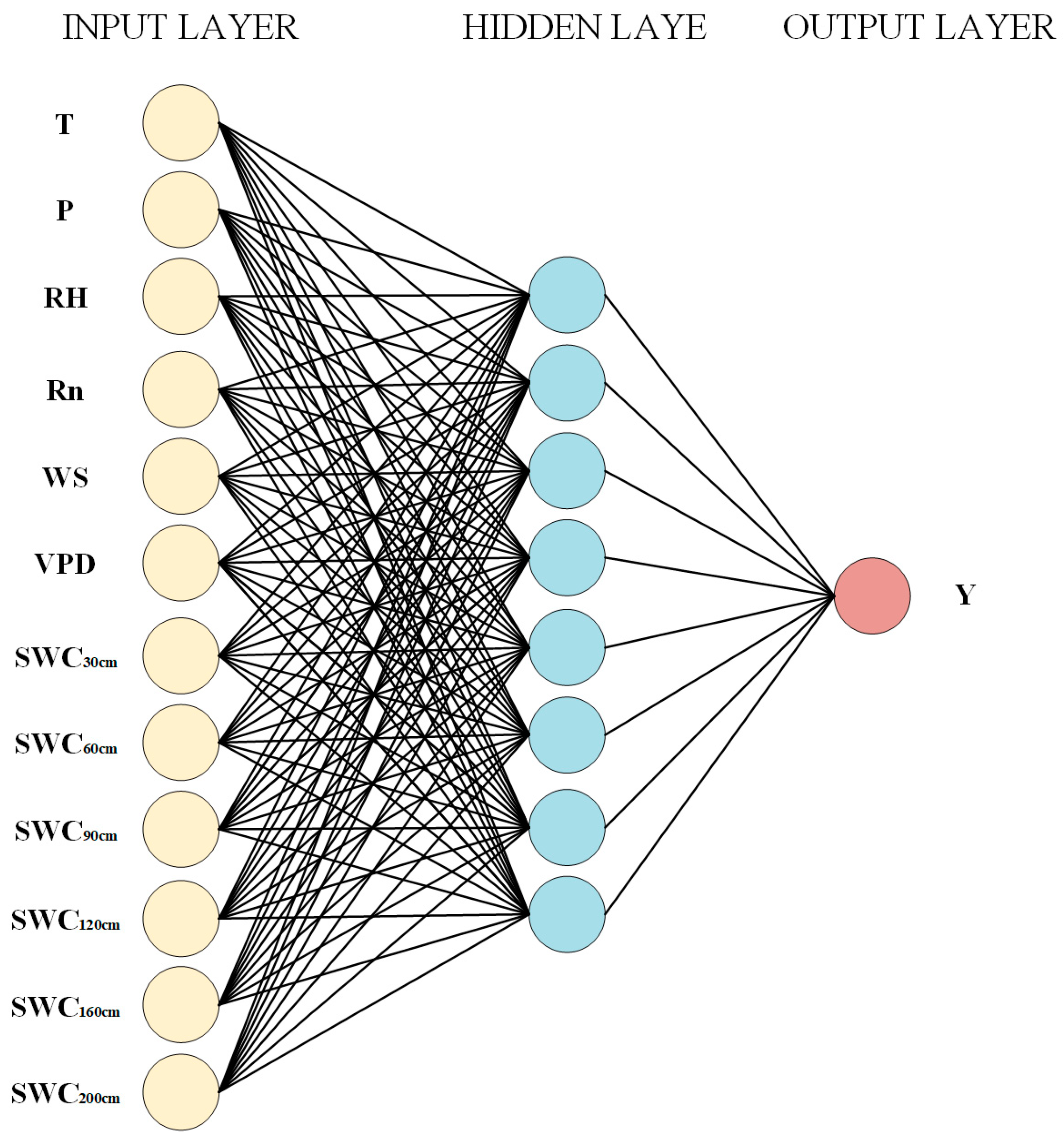
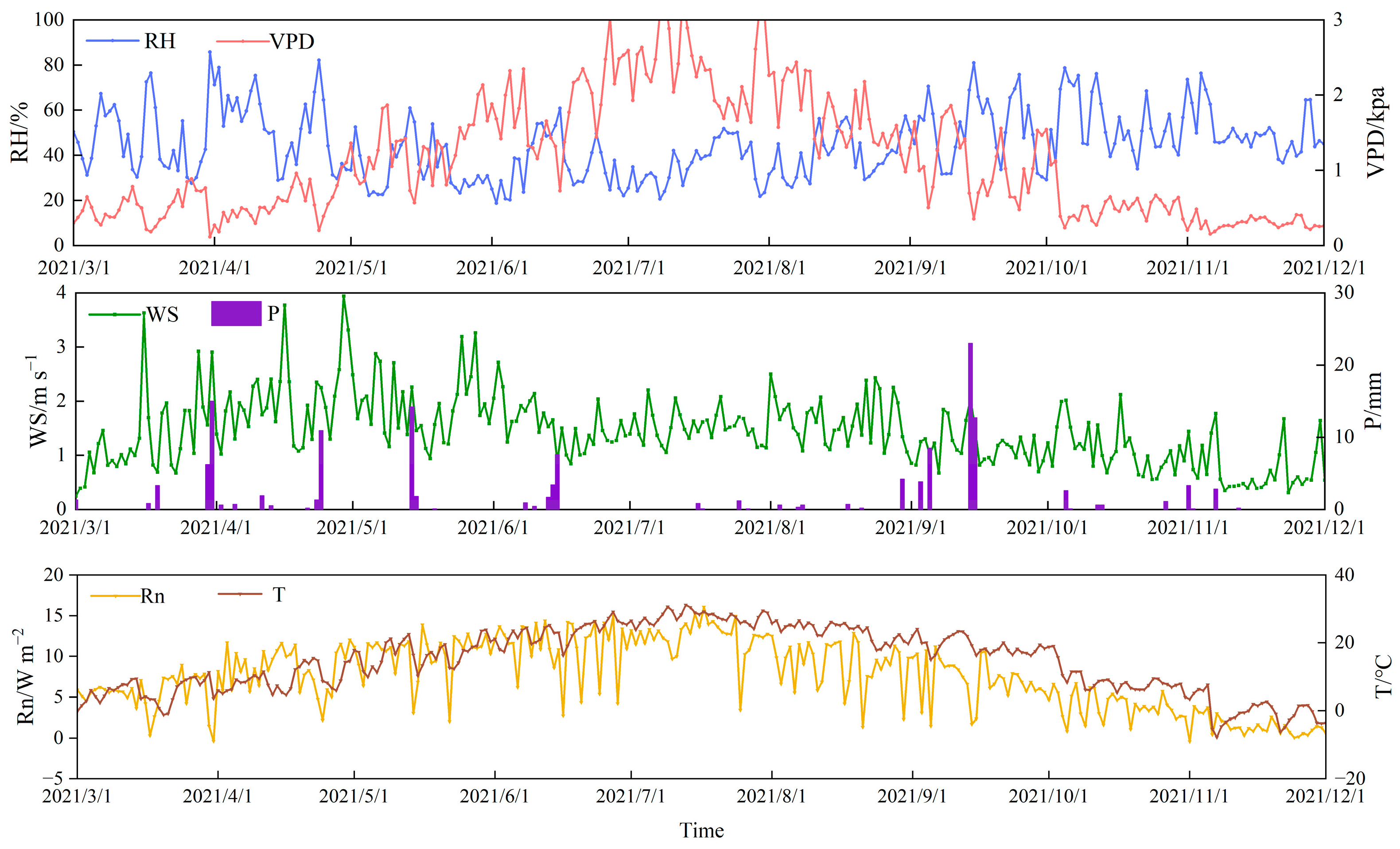
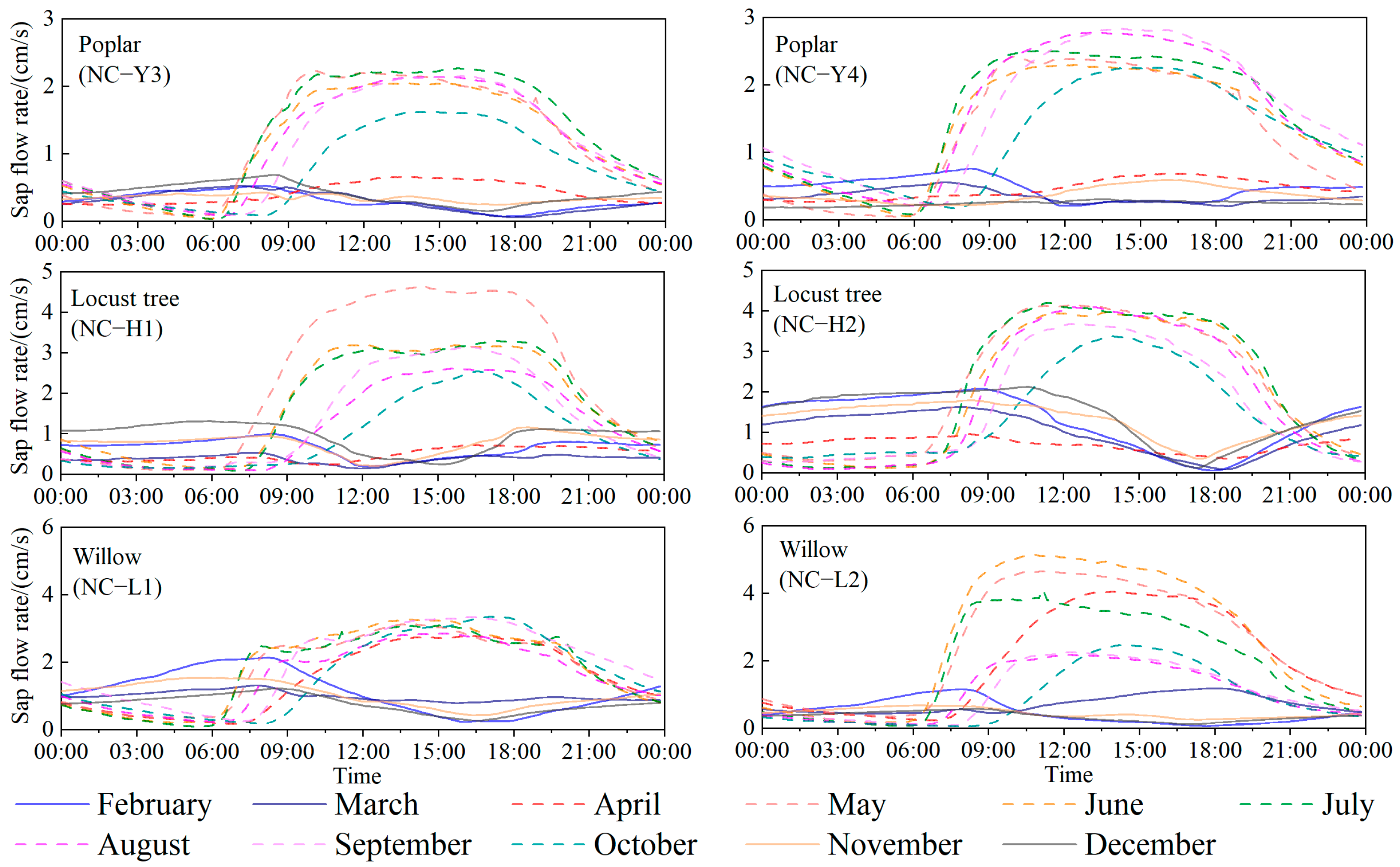

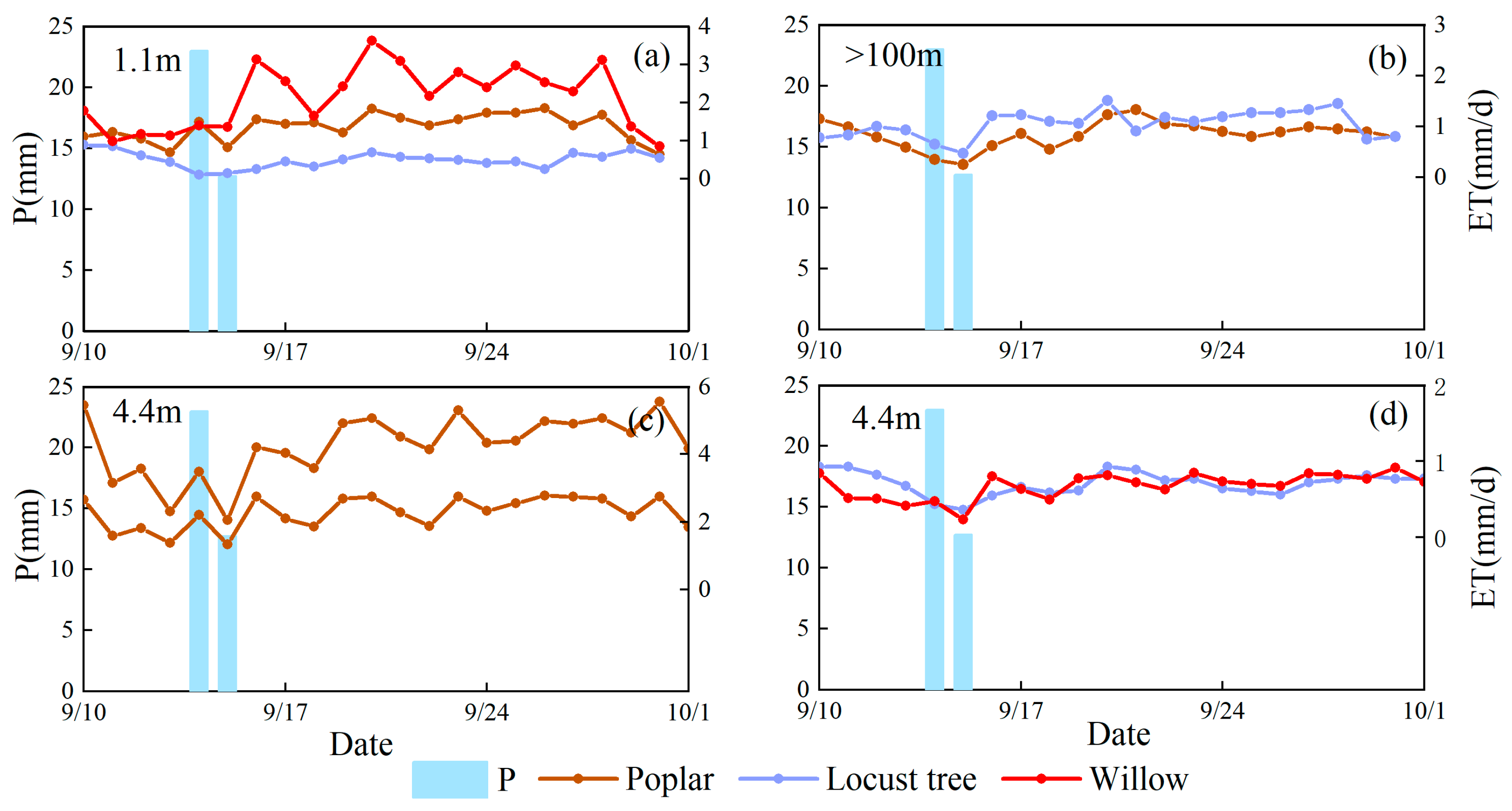

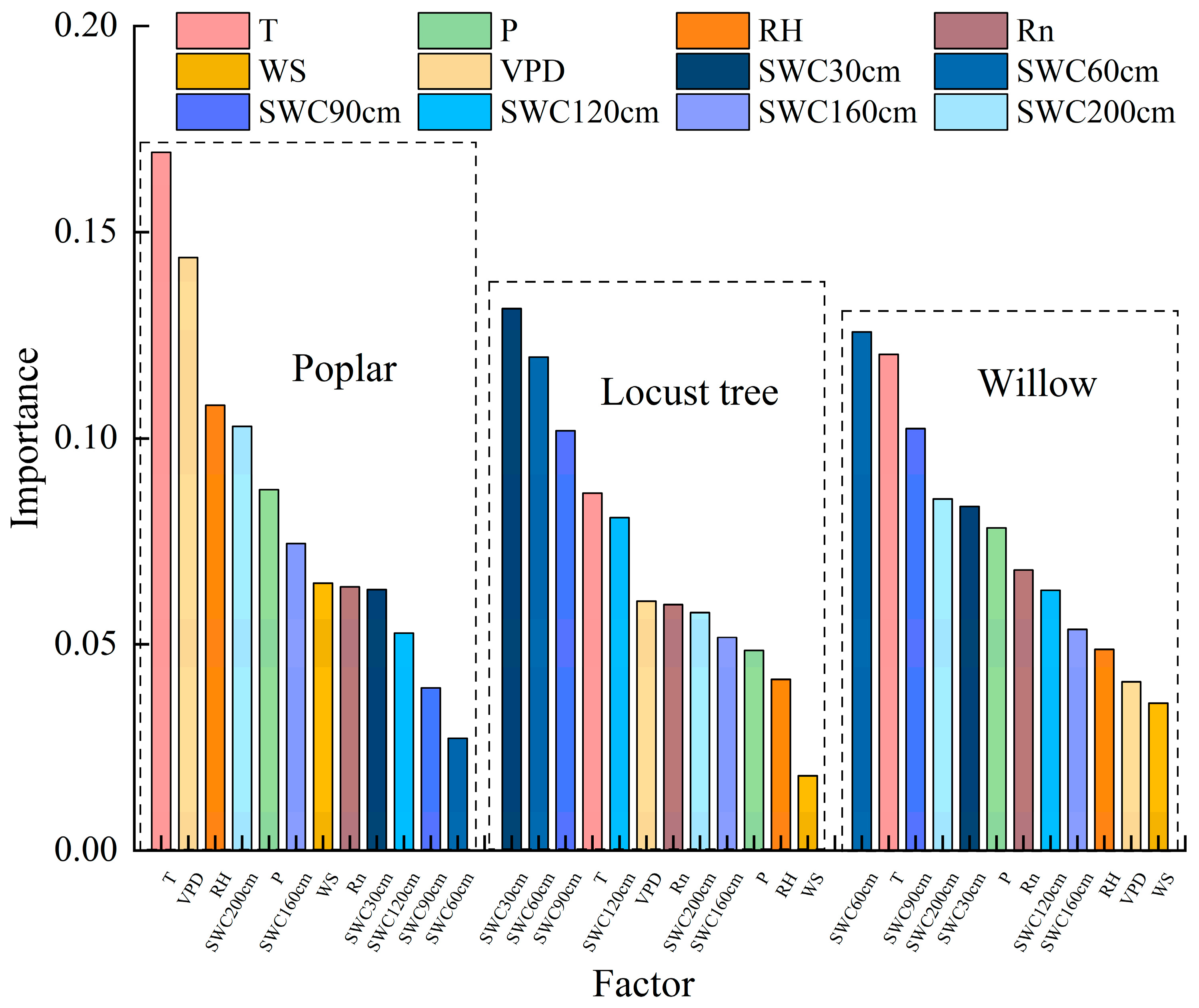
| State | Number | Varieties of Trees | DBH (cm) | Height (m) | CW (m × m) | TDP (mm) |
|---|---|---|---|---|---|---|
| Ningxia central station | NC-H1 | locust tree | 7.8 | 5.7 | 2.9 × 3.7 | TDP30 |
| NC-H2 | locust tree | 7.9 | 5.9 | 3.4 × 4.7 | TDP30 | |
| NC-Y1 | poplar | 16.8 | 16.5 | 2.2 × 2.4 | TDP50 | |
| NC-Y2 | poplar | 22.7 | 18.8 | 2.9 × 3.6 | TDP 80 | |
| NC-L1 | willow | 14.5 | 10.1 | 4.7 × 6.3 | TDP 50 | |
| NC-L2 | willow | 22.6 | 11.7 | 9.2 × 10.8 | TDP 50 | |
| NC-H3 | locust tree | 8.8 | 16.2 | 3.6 × 4.1 | TDP 30 | |
| NC-H4 | locust tree | 12.8 | 9.5 | 3.2 × 4.5 | TDP 30 | |
| NC-Y3 | poplar | 24.2 | 18.7 | 2.5 × 4.5 | TDP 80 | |
| NC-Y4 | poplar | 32.3 | 23.5 | 3.1 × 2.8 | TDP 80 | |
| NC-Y5 | poplar | 33.8 | 29.4 | 3.3 × 2.2 | TDP 80 | |
| NC-Y6 | poplar | 42 | 29.6 | 5.5 × 4.4 | TDP 100 | |
| Huinongqu station | HN_L1 | willow | 14.9 | 8.9 | 3.4 × 4.3 | TDP 50 |
| HN_L2 | willow | 11.0 | 6.8 | 1.8 × 2.4 | TDP 30 | |
| HN_Y1 | poplar | 12.5 | 12.1 | 2.5 × 4.5 | TDP 50 | |
| HN_Y2 | poplar | 7.9 | 8.9 | 2.1 × 3.0 | TDP 30 | |
| Suyukou station | SY_Y1 | poplar | 13.8 | 8.9 | 2.5 × 4.5 | TDP 50 |
| SY_Y2 | poplar | 16.0 | 9.1 | 2.7 × 4.3 | TDP 50 | |
| SY_H1 | locust tree | 7.0 | 6.3 | 2.2 × 2.7 | TDP 30 | |
| SY_H2 | locust tree | 7.2 | 6.4 | 2.0 × 2.8 | TDP 30 | |
| Forestpark station | FP_Y1 | poplar | 18.0 | 7.1 | 3.4 × 3.0 | TDP 50 |
| FP_Y2 | poplar | 12.0 | 7.2 | 3.3 × 2.9 | TDP 50 | |
| FP_H1 | locust tree | 12.4 | 6.5 | 3.7 × 4.3 | TDP 30 | |
| FP_H2 | locust tree | 10.0 | 6.3 | 2.9 × 3.1 | TDP 30 | |
| Shizuishan station | SZS_Y1 | poplar | 22.9 | 13.4 | 2.7 × 4.3 | TDP 80 |
| SZS_Y2 | poplar | 30.9 | 16.0 | 3.4 × 3.0 | TDP 80 | |
| SZS_H1 | locust tree | 12.4 | 6.0 | 3.8 × 4.2 | TDP 50 | |
| SZS_H2 | locust tree | 13.7 | 8.2 | 3.6 × 4.4 | TDP 50 | |
| SZS_L1 | willow | 35.7 | 12.6 | 7.6 × 9.3 | TDP 80 |
| Number | DBH (cm) | CW (m × m) | April | May | June | July | August | September | October |
|---|---|---|---|---|---|---|---|---|---|
| NC-Y3 | 24.2 | 2.5 × 4.5 | \ | 5:30 | 5:50 | 6:10 | 6:30 | 7:00 | 7:50 |
| NC-Y4 | 32.3 | 3.1 × 2.8 | \ | \ | 5:40 | 5:50 | 6:10 | 6:50 | 7:30 |
| NC-H1 | 7.82 | 2.9 × 3.7 | \ | 6:20 | 6:50 | 7:10 | 8:00 | 8:30 | 9:00 |
| NC-H2 | 7.95 | 3.4 × 4.7 | \ | 6:10 | 6:30 | 6:50 | 7:10 | 7:50 | 8:10 |
| NC-L1 | 15.45 | 4.7 × 6.3 | 6:50 | 6:10 | 6:00 | 6:00 | 6:20 | 7:20 | 8:10 |
| NC-L2 | 22.60 | 9.2 × 10.8 | 6:40 | 6:10 | 6:00 | 6:00 | 6:20 | 7:10 | 7:50 |
| GD | Varieties of Trees | Rn | T | RH | VPD | WS |
|---|---|---|---|---|---|---|
| 1.1 m | poplar | 0.854 ** | 0.735 ** | −0.622 ** | 0.819 ** | 0.135 * |
| locust tree | 0.502 ** | 0.294 ** | −0.559 ** | 0.407 ** | 0.053 | |
| willow | 0.891 ** | 0.813 ** | −0.501 ** | 0.754 ** | 0.034 | |
| 4.4 m | poplar | 0.319 ** | 0.185 * | −0.155 * | 0.151 * | −0.145 * |
| locust tree | 0.703 ** | 0.535 ** | −0.646 ** | 0.621 ** | 0.105 | |
| willow | 0.435 ** | 0.148 * | −0.262 ** | 0.175 * | 0.103 | |
| >100 m | poplar | 0.813 ** | 0.683 ** | −0.609 ** | 0.774 ** | 0.040 |
| locust tree | 0.807 ** | 0.765 ** | −0.417 ** | 0.752 ** | −0.036 |
| Water Source | Soil Depth (cm) | Soil Moisture Content before Precipitation (%) | Maximum Moisture Content after Precipitation (%) | Increment in Moisture Content (%) |
|---|---|---|---|---|
| Precipitation | 30 | 4.75 | 15.09 | 10.34 |
| 60 | 4.12 | 8.65 | 4.53 | |
| 90 | 0.55 | 0.77 | 0.22 | |
| 120 | 0 | 0 | \ | |
| 160 | 2.03 | 2.03 | \ | |
| 200 | 0.20 | 0.20 | \ | |
| First drip irrigation | 30 | 4.64 | 18.35 | 13.71 |
| 60 | 4.12 | 17.74 | 13.62 | |
| 90 | 0.45 | 14.35 | 14.13 | |
| 120 | 0 | 8.30 | 8.08 | |
| 160 | 4.76 | 16.23 | 11.47 | |
| 200 | 0.51 | 8.95 | 8.45 | |
| Second drip irrigation | 30 | 4.60 | 17.43 | 12.83 |
| 60 | 4.07 | 16.61 | 12.54 | |
| 90 | 0.63 | 12.17 | 11.54 | |
| 120 | 0 | 8.69 | 8.69 | |
| 160 | 1.83 | 15.29 | 13.46 | |
| 200 | 0 | 7.74 | 7.74 |
| GD | Varieties of Trees | SWC30cm | SWC60cm | SWC90cm | SWC120cm | SWC160m | SWC200cm |
|---|---|---|---|---|---|---|---|
| 1.1 m | poplar | 0.501 * | 0.550 ** | −0.131 | 0.192 | 0.111 | −0.150 |
| locust tree | 0.168 | −0.099 | −0.046 | 0.261 | −0.032 | −0.050 | |
| willow | 0.588 ** | 0.740 ** | 0.068 | 0.226 | −0.016 | −0.120 | |
| 4.4 m | poplar | 0.480 * | 0.514 * | −0.273 | −0.157 | 0.353 | 0.583 ** |
| locust tree | 0.171 | 0.122 | −0.351 | −0.535 * | −0.031 | −0.706 ** | |
| willow | 0.236 | 0.391 | 0.173 | 0.167 | 0.525 * | −0.101 | |
| >100 m | poplar | 0.041 | 0.784 ** | 0.476 | −0.412 | −0.148 | 0.154 |
| locust tree | 0.187 | 0.491 * | 0.145 | −0.035 | −0.097 | 0.437 |
| GD | Varieties of Trees | SWC30cm | SWC60cm | SWC90cm | SWC120cm | SWC160m | SWC200cm |
|---|---|---|---|---|---|---|---|
| 4.4 m | locust tree | −0.014 | 0.033 | 0.069 | 0.193 | 0.218 | 0.097 |
| willow | −0.293 | −0.304 | −0.186 | −0.152 | −0.146 | 0.100 |
Disclaimer/Publisher’s Note: The statements, opinions and data contained in all publications are solely those of the individual author(s) and contributor(s) and not of MDPI and/or the editor(s). MDPI and/or the editor(s) disclaim responsibility for any injury to people or property resulting from any ideas, methods, instructions or products referred to in the content. |
© 2024 by the authors. Licensee MDPI, Basel, Switzerland. This article is an open access article distributed under the terms and conditions of the Creative Commons Attribution (CC BY) license (https://creativecommons.org/licenses/by/4.0/).
Share and Cite
Li, X.; Zhai, J.; Sun, M.; Liu, K.; Zhao, Y.; Cao, Y.; Wang, Y. Characteristics of Changes in Sap Flow-Based Transpiration of Poplars, Locust Trees, and Willows and Their Response to Environmental Impact Factors. Forests 2024, 15, 90. https://doi.org/10.3390/f15010090
Li X, Zhai J, Sun M, Liu K, Zhao Y, Cao Y, Wang Y. Characteristics of Changes in Sap Flow-Based Transpiration of Poplars, Locust Trees, and Willows and Their Response to Environmental Impact Factors. Forests. 2024; 15(1):90. https://doi.org/10.3390/f15010090
Chicago/Turabian StyleLi, Xing, Jiaqi Zhai, Meng Sun, Kuan Liu, Yong Zhao, Yankun Cao, and Yong Wang. 2024. "Characteristics of Changes in Sap Flow-Based Transpiration of Poplars, Locust Trees, and Willows and Their Response to Environmental Impact Factors" Forests 15, no. 1: 90. https://doi.org/10.3390/f15010090
APA StyleLi, X., Zhai, J., Sun, M., Liu, K., Zhao, Y., Cao, Y., & Wang, Y. (2024). Characteristics of Changes in Sap Flow-Based Transpiration of Poplars, Locust Trees, and Willows and Their Response to Environmental Impact Factors. Forests, 15(1), 90. https://doi.org/10.3390/f15010090






